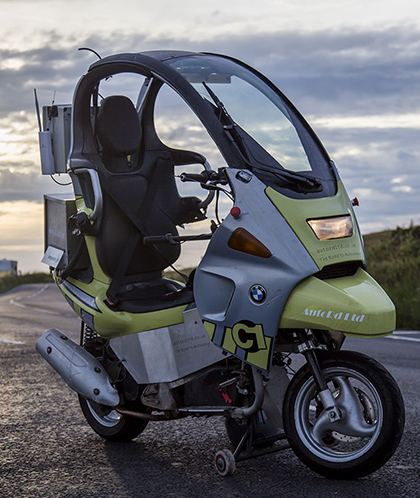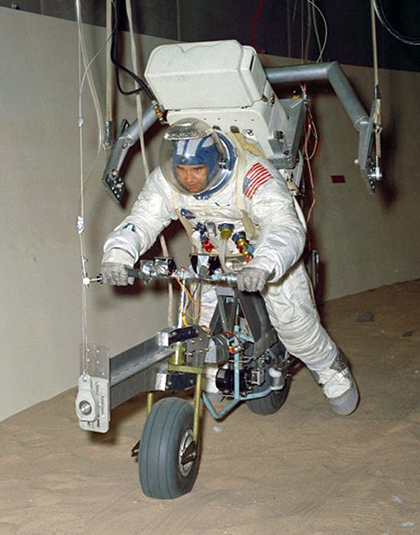 United States – Washington, DC – It’s the same the whole world over as concerns about “Self-driving” cars see the Motorcycle Riders Foundation (MRF) raise their own concerns again on automated vehicles at a briefing of the Senate Motorcycle Caucus.
United States – Washington, DC – It’s the same the whole world over as concerns about “Self-driving” cars see the Motorcycle Riders Foundation (MRF) raise their own concerns again on automated vehicles at a briefing of the Senate Motorcycle Caucus.
Basically the Congressional Motorcycle Caucus addresses common legislative objectives through a group of politicians that meets to pursue, “The specific and crucial needs of motorcycle riders and all those that share the road with them – legislators with a unique understanding and commitment to the issues that face riders everywhere.”
In the UK Parliament a similar “political grouping” exists the – All-Party Parliamentary Motorcycling Group – whose purpose is listed as, “To safeguard motorcycling interests by monitoring legislation for matters affecting motorcycling and taking remedial action where necessary; to represent motorcycling to fellow parliamentarians; to foster the good image of motorcycling, and, by example, encourage others to take up motorcycling. provide a valuable opportunity for parliamentarians to engage with individuals and organisations outside Parliament who share an interest in the subject matter of their Group.”
Whether there are similar organised legislative groups in other countries, we don’t know, as far as we are aware none exist at the European Parliament, however we digress.
What we do have from the United States, are legislators who can react with riders organisations on the concerns of the day and for the future which right now is requiring, “automakers and technology developers to include motorcycle recognition, identification and responsiveness …….. regarding Self-Driving Cars.”
Lawmakers & Staff Gather to Discuss Self-Driving Cars & Motorcyclists’ Concerns
8th February 2018
 The MRF’s own briefing on the discussions regarding Self-Driving Cars and the concerns of motorcyclists is as follows:
The MRF’s own briefing on the discussions regarding Self-Driving Cars and the concerns of motorcyclists is as follows:
Senators Gary Peters (D-MI) and Joni Ernst (R-IA) opened the briefing as the Chairs of the Caucus. Both avid riders, they discussed the need to be inclusive of all roadway users when advancing legislation and regulations related to the emerging technology.
Both agreed that the Senate Bill – the AV START Act – and which Peters helped to author, would achieve this. Specifically, they addressed a section of the legislation that required automakers and technology developers to include motorcycle recognition, identification and responsiveness in a required safety report that would be reviewed by the National Highway Traffic Safety Administration.
Panellists chosen to address the audience (packed with Congressional and Administration staff from the Department of Transportation, National Highway Traffic Safety Administration and the Federal Highway Administration along with motorcycle industry representatives including Harley-Davidson, and the Motorcycle Riders Foundation) discussed that while automated driving technology could yield tremendous benefits for riders by helping to eliminate driver error, motorcyclists were wary of how they fit into this new driving environment.
At one point, the discussion turned to detection by other road users as a constant challenge for the nearly 8.5 million registered motorcycles in the U.S. Distracted driving is on the rise according the latest reports from the National Highway Traffic Safety Administration (NHTSA) and the failure by some motorists to “see” motorcycles with their smaller profile can end in disastrous – and often fatal – consequences. But whether self-driving vehicles would actually improve this problem remains up for debate.
Panelists recognized the obvious need to make sure that automated vehicles would appropriately detect and respond to motorcyclists. However, some feared that this message has been diluted. The recent NHTSA guidance on driverless vehicles failed to mention motorcycles in this context whatsoever. Further reinforcing this concern was an incident last year involving a Tesla vehicle operating on autopilot. The vehicle struck a police officer on a motorcycle in Phoenix, AZ. Even recently, news reports surfaced about Chevy Bolt which allegedly veered into a motorcyclist while traveling on a San Francisco freeway while on autopilot.
Panelist John Lenekit from Dynamic Research discussed his preliminary research which reviewed a driver assist technology that was currently on the road; forward collision warning systems. Designed to alert the driver if they were too rapidly approaching the vehicle in front of them, this technology is widely-used in the current market, even coming standard on some makes and models. Dynamic Research’s project looked at the reliability of this warning system and found that between car to car, the warning system worked over 90% of the time. However, with a car approaching a stopped motorcycle, the warning system failed 40% of the time either warning the driver too late, or failing to warn the driver at all.
This research lead into the discussion about what was needed to ensure motorcyclists’ safety and the entire panel agreed that more motorcycle specific research was needed – and fast.
The panel concluded by musing on a question raised by the audience. The Motorcycle Riders Foundation’s chief advocacy officer pressed the panel on how motorcycles fit into a world with truly autonomous vehicles. Citing potential disincentives to drive as a way to achieve market penetration for self-driving cars, she asked panelists how motorcycles could co-exist, if at all.
Harley-Davidson’s Director of Government Affairs Ed Moreland responded, “We need to continue to tell the story of motorcycles – they omit less emissions into the atmosphere, cause less stress, wear and tear on our nation’s infrastructure, decrease traffic congestion and improve travel times – there is a world for motorcycles. As long as there are riders, there will be motorcycles.”
And as for self-driving motorcycles? “I will NEVER ride a self-driving motorcycle,” stated Sen. Peters. “Doesn’t that defeat the entire purpose?”
The riders in the audience responded with rousing applause.
The Same In Europe
 The same concerns have been raised in Europe from rider organisations such as the Federation of European Motorcyclists (FEMA) – “FEMA has been asking for inclusion of motorcycles in the development and testing of ADAS (Advanced Driver Assistance Systems), which include automatic emergency braking systems for some years now, because we learned from tests and from real accidents that these systems often do not react properly to motorcycles.” and similar to the United States of at least one high profile collision in Norway when a 19-year-old female motorcyclist was rammed by a Tesla in autopilot mode.
The same concerns have been raised in Europe from rider organisations such as the Federation of European Motorcyclists (FEMA) – “FEMA has been asking for inclusion of motorcycles in the development and testing of ADAS (Advanced Driver Assistance Systems), which include automatic emergency braking systems for some years now, because we learned from tests and from real accidents that these systems often do not react properly to motorcycles.” and similar to the United States of at least one high profile collision in Norway when a 19-year-old female motorcyclist was rammed by a Tesla in autopilot mode.
Two years ago FEMA joined forces with organisation in the Netherlands – KNMV and MAG NL writing to the RDW, the Netherlands Vehicle Authority regarding the European whole vehicle type approval for all Tesla models, to “Ensure that motorcycles, in fact all two-wheelers, can use our roads without being hit from behind by a malfunctioning Tesla or other vehicle with a poorly tested automatic emergency breaking (sic) system.”
FEMA reported last year that the progress of RDW’s research into the visibility of motorcyclists by supporting systems in cars had been presented to MAG NL, FEMA and KNMV which found that the car was found to, “automatically adjust its speed at the time the motorcycle entered the detection field. The moment a motorcycle overtook the car, the car also responded as it should. When the motorcycle drove slower than the car after the overtaking manoeuvre, the system also registered this and adjusted the speed of the car.” RDW also stated, “Further research on other brands and types of vehicles will follow in the coming months. The RDW will check whether, when and how passenger cars with Adaptive Cruise Control and other Advanced Driver Assistance Systems react when they approach a motorcycle.” as suggested there are still concerns as more research is needed.
Recently we reported on the European Association of Motorcycle Manufacturers’ (ACEM) position on the Detection of motorcycles by advanced driver assistance systems (ADAS) which states that, “it is essential that ADAS correctly identify all road users, including motorcycles”.
In that report we mention that the European Parliament has called on the European Commission to make it compulsory to install automatic emergency braking assistance with detection of pedestrians, cyclists, light powered two-wheelers and motorcyclists, in cars, light commercial vehicles, buses, coaches and, especially, heavy goods vehicles – with the European Commission assuring us to our query of their awareness on electronic warning systems – Forward Collision Warning Systems – Advanced Emergency Braking Systems to be taken on board as regards PTWs and that they do take PTW concerns very seriously.
FIM Europe has with FEMA, a joint position that:
- Motorcycles differ from bicycles and pedestrians in speed and acceleration. ADAS devices should be developed with all kinds of vulnerable road users in mind and should always be tested with motorcycles.
- ADAS devices must be developed and tested with non-ADAS equipped road users in mind.
Strategic EU Road Safety Framework
In May 2018 the European Commission is due to publish its Strategic EU road safety framework for 2020-2030 and as reported by FIA Region 1 – Federation Internationale de l’Automobile a meeting of, “key road safety players in Europe to start a reflection on how to improve road safety in the next decade.” organised by the European Commissioner for Transport Violeta Bulc, took place recently with the group identify key areas for improvement in road safety in the future between 2020 and 2030.
One of those key areas was the, “Trial and deployment of future vehicle technologies” which one would hopefully assume the consideration of motorcycles and their riders. Thankfully looking at the group photograph from the “brainstorming” day we see that Antonio Perlot, the General Secretary of ACEM and a motorcyclist, was in attendance with a few others who possibly are motorcycle, scooter, Powered Two Wheeler Riders.
As we have reported on and also mentioned the FIM Public Affairs analysis article the European Parliament report called for, “an extension of the emergency braking requirement for trucks and buses to include detection of vulnerable road users, also noting that driver assistance systems, autonomous vehicles and over-ridable intelligent speed assistant systems could have a significant impact on road safety for all users.”
Specifically, the European Parliament has called on the European Commission to make it compulsory to install automatic emergency braking assistance with detection of pedestrians, cyclists, light powered two-wheelers and motorcyclists, in cars, light commercial vehicles, buses, coaches and, especially, heavy goods vehicles. When we contacted the European Commission, they assured us of their awareness of electronic warning systems – Forward Collision Warning Systems – Advanced Emergency Braking Systems and concerns are being taken on board as regards PTWs and that they do take PTW concerns very seriously.
However the European Transport Safety Council (ETSC) has voiced Safety concerns over mystery exemption to EU safety rules – that in a behind-closed-doors meeting in December of the “Technical Committee – Motor Vehicles” (TCMV, ) “EU Member State representatives approved a European Commission decision to grant the German government permission to certify EU-wide a new vehicle with an automated lane changing system.”
Antonio Avenoso, Executive Director of ETSC commented: “Carmakers are rushing to market new features that come with unknown safety risks, and the power to decide on their approval is held by an obscure technical committee that does not publish detailed information about the systems it exempts or any kind of safety impact assessment. The EU, can and must do better than this.
Here we have a system that can move a vehicle into the next lane and we have no idea what sensors it uses, whether it looks in front as well as behind the vehicle, what objects it can recognise, under what weather conditions it operates or what other factors are taken into account.
There should be full disclosure by manufacturers of the systems they want exempted, full details of the testing regime that has been applied, and, as a minimum, the committee should publish a detailed opinion on why it considers the exempted system to be safe.“
Overall, from the United States to European rider organisations, concerns are being placed in front of legislators who seem to be listening, but time will tell. The case for the motorcycle industry is a bit more complicated in wanting to introduce new technologies, riders’ acceptance on the vehicles they produce and sell, while balancing road safety concerns between other vehicles.
Tesla Into Space
 We suppose if asking about automated self-driving cars, our immediate thoughts turn to Elon Musk the driving force behind Tesla Motors, onwards and beyond of SpaceX and his “brand” of technological advancement.
We suppose if asking about automated self-driving cars, our immediate thoughts turn to Elon Musk the driving force behind Tesla Motors, onwards and beyond of SpaceX and his “brand” of technological advancement.
While Musk can put a Tesla motor in space, is there need for concern that failure is not designed by default, into these systems of non-recognition of motorcyclists? Rather than improving the fallibility of humans technology, perhaps it is not improving this but imitating human failure.
Meanwhile as Elon Musk’s Tesla floats across space you can track its location with Starman onboard at – www.whereisroadster.com – moving towards Mars at a speed of 43,117 miles/hour (69,390 km/hour, 19.28 km/s) let’s hope if they cross paths with an interstellar motorcycle, scooter, moped riding alien that any automated driver assist technology system fitted is in working order.
Previous Articles on Automation – Motorcycle Minds
Motorcycle Riders Foundation (MRF) – www.mrf.org – On Facebook – On Twitter
AutoRD Limited – The Road To Autonomous Motorcycles


Leave a Reply